Does Air Quality Influence the Spread of the SARS - COV2 in Metropolitan Cities? - A Case Study from Urban India
DOI: http://dx.doi.org/10.12944/CWE.16.2.27
Copy the following to cite this article:
Basu S, Das R, Gupta S, Ganguli S. Does Air Quality Influence the Spread of the SARS - COV2 in Metropolitan Cities? - A Case Study from Urban India. Curr World Environ 2021;16(2). DOI:http://dx.doi.org/10.12944/CWE.16.2.27
Copy the following to cite this URL:
Basu S, Das R, Gupta S, Ganguli S. Does Air Quality Influence the Spread of the SARS - COV2 in Metropolitan Cities? - A Case Study from Urban India. Curr World Environ 2021;16(2). Available From : https://bit.ly/3bNhcEO
Download article (pdf)
Citation Manager
Publish History
Select type of program for download
| Endnote EndNote format (Mac & Win) | |
| Reference Manager Ris format (Win only) | |
| Procite Ris format (Win only) | |
| Medlars Format | |
| RefWorks Format RefWorks format (Mac & Win) | |
| BibTex Format BibTex format (Mac & Win) |
Article Publishing History
| Received: | 09-09-2020 |
|---|---|
| Accepted: | 12-05-2021 |
| Reviewed by: | 
 Sneha Gautam
Sneha Gautam
|
| Second Review by: |

 Sourav Poddar
Sourav Poddar
|
| Final Approval by: | Dr. Sabu Joseph |
Introduction
The symptoms of the current pandemic were first reported from Wuhan (China) in December 2019, when there was an abrupt increase in the number of fatal pneumonia cases. Gradually as the virus started spreading all around the world through International travel, it was identified to be a novel coronavirus and was nomenclatured as SARS-COV2 due to its homology with the earlier strain of the Severe Acute Respiratory Syndrome (SARS) virus that ravaged the world as an epidemic in the years 2002 and 2003. The disease was named as COVID-19.1-3 The impact of SARS-CoV-2 has been devastating around the world. So far 213 countries, more than 2.5 million people has been affected till date and more than 150,000 individuals have died.4 Initially the disease had spread in Wuhan and later on it spread globally within the first four months.5 Recent data of WHO identify over 2.8 million cases with over 201.000 victims as accessed on April 27, 2020.6-8 As of 6th July, globally the pandemic caused almost 11 million confirmed cases of infection and more than 2 million deaths.5 Most of the countries are trying to fight the spread of the virus by halting all social interactions. Social distancing parameters are being revised as continuous research is providing evidences of fomite, droplet and aerosol transmission in closed social environments without proper ventilation and continuous sanitization routines. In India the first confirm case was detected on January 30th, 2020 and the report of infection has rapidly increased from March 16th continuously. Government had declared the first nationwide lockdown for fourteen hours on March 22nd which was followed by 21 days of lockdown from 24th March. All the places of mass gatherings such as academic institutions, shopping malls, theatres, supermarkets and industries were declared to be closed across the country. This lockdown has mandated reduced transportation and industrial productivity which resulted into reduced automobile and industrial emissions.
As various countries had implemented lockdown measure, climate researchers had predicted that this implementation has the potential to positively impact global environment by cutting down greenhouse gas emission.9 Improved air quality was achieved as a result of reduced vehicular and industrial pollution due to the closure of majority of workshops and factories. A study showed that in France, Germany and Italy the NO2 and greenhouse gas has been reduced significantly after lockdown.10 Europe also reported reduction in air pollution after Government had ordered countrymen to stay at home for preventing the COVID outbreak which halted the factory & industrial work and automobile emissions that showed a drastic reduction in atmospheric NO2 and Particulate matter proportions.11 Studies also showed that the air pollution increased the risk of influenza infection.12 These trends of correlation also have been seen in SARS and MERS.13
The world is a polluted place in terms of air quality with 91% of our fellow citizens living in places with poor and polluted air. 14 Each year the global mortality rate due to lack of good quality air has significantly increased.15 The Global Disease Study showed that outdoor air pollution caused almost 4.2 million premature deaths in 2015.16 In this regard another report of WHO in the year 2016 indicated that in Europe, Asia and Africa air pollution contributed almost 8 % of total death.
Developing countries such as India and other countries around the world has increasingly sacrificed air quality control in favour of deforestation, industrialization and urbanization. This has resulted in severe health issues such as Chronic Obstructive Pulmonary Disease (COPD) increasing in number and in 2015 nearly one million deaths were corelated to particulate matter pollution.17 The World Health Organization and Central Pollution Control Board (CPCB) have established standard for ambient air quality, however major Indian cities have flouted the parameters and have consistently being enlisted in the top 20 most polluted cities of the world in the last few years.18-19
United States, Environmental Protection Agency (EPA), have identified several severe health and environmental hazards to be caused by “criteria pollutant”, such as carbon monoxide, lead, particulate air pollutants and variations in ground ozone level, which have resulted in smog, acid rain etc. All this are covered under the Clean Air Act of 1963. In India monitoring of air pollutant is performed by Central Pollution Control Board (CPCB) which jurisdiction of the Air (Prevention and Control of Pollution) Act, 1981. According to National Air Quality Monitoring Programme (NAMP), regular monitoring is performed for particulate matter (PM10), sulphur dioxide (SO2) and nitrogen dioxide (NO2) at all the monitoring stations. Real time monitoring of air quality is achieved by calculating the Air quality index (AQI) which takes into account various pollutants such as Pb, NH3, SO2, NO2, CO, O3, PM10 and PM2.5 Table 1). Particulate matter (PM), SO2, NO2, NH3, CO and O3 are considered as classical air pollutants to calculate air quality under the programme of NAMP. Few recent studies have reported the importance of air quality and its impact during the period of lockdown in India as a result of the prevalent pandemic. 20-23. In India, Delhi and other metropolitan cities have caused severe air pollution in last few years which was very clear from the recorded air quality previously.24
Table 1: List of Air Pollutants and Their Sources.
|
Serial Number |
Pollutant |
Source |
Remarks/Source |
|
1 |
PM2.5 and PM10 |
Primary sources are incomplete combustion, automobile emissions, dust and Cooking exhaust. Chemical reactions in the atmosphere also act as a secondary source. |
https://doi.org/10.1016/j.atmosenv.2013.01.032 25 |
|
2 |
NO2 |
Outdoor source- Traffic emissions. Indoor source- (Appliances used for cooking), (Gas, Oil, Wood etc). |
https://www.ncbi.nlm.nih.gov/books/NBK138707/ 26 |
|
3 |
NH3 |
Principal source- Ammonia based fertilizer used in agriculture and livestock maintenance. |
https://doi.org/10.1007/s11356-013-2051-9 27 |
|
4 |
SO2 |
Principal source- Fossil fuel burning in thermal power plant and other industry. |
https://www.epa.gov/so2-pollution/sulfur-dioxide-basics 28 |
|
5 |
CO |
Principal source- Vehicular emissions and burning of fossil fuel. |
https://www.epa.gov/co-pollution/basic-information-about-carbon-monoxide-co-outdoor-air-pollution 29 |
|
6 |
Ozone |
Sunlight mediated formation of ozone (ground level) by reaction between nitrogen oxide and emitted volatile organic compounds from various urban and industrial sources. |
https://www.epa.gov/ground-level-ozone-pollution/ground-level-ozone-basics 30 |
This work focused on the change in AQI and ambient air pollutants during lockdown in selected cities to construct a correlation between the air quality and outbreak of the COVID infection in search of the impact of air pollutants on viral invasion.
Materials and Methods
Study Design
Seven metropolitan cities viz Delhi, Mumbai, Kolkata, Bengaluru, Hyderabad, Chennai (Fig. 1) and over 74 monitoring stations were sampled in this study for a period of three months.
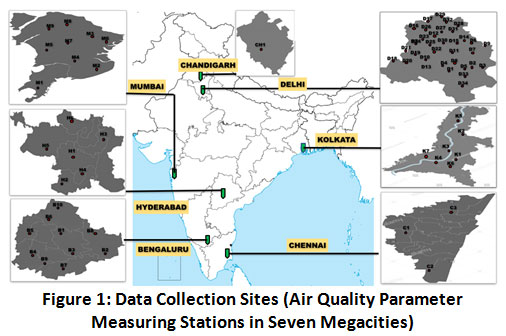 |
Figure 1: Data Collection Sites (Air Quality Parameter Measuring Stations in Seven Megacities) Click here to view Figure |
The span of 1st February to 20th March was chosen as there was no lockdown imposed by the government and the data could provide clear picture of air pollution in city specific manner. This time span was designated as the pre lockdown period for this analysis. The Government had ordered total lockdown from 22nd March to the end of April, when there was significantly restricted emission of industrial and vehicular pollution. Later in the month of May (Unlock1) and June (Unlock2) there were gradual relaxation of the lockdown norm declared by the government. Thus for this analysis, data up to the month of April was considered appropriate for the post lockdown period (Table 2).
Table 2: Description of Datasets and Periods of Pre and Post Lockdown Considered in the Study.
|
Serial Number |
Nomenclature |
Period |
Explanation |
|
1 |
Pre-Lockdown |
February-Mid March |
Before the enforcement of complete lockdown. |
|
2 |
Post-Lockdown |
Mid-March-April |
During the period of complete lockdown without any relaxation activity |
Data Collection
Data was collected from The Central Pollution Control Board (CPCB) database (https://app.cpcbccr.com/AQI_India) which is under National Air Quality Monitoring programme (NAMP). Pollutants are monitored for a period of twenty-four hour (gaseous pollutant at 4-hour interval and particulate matter at 8-hour interval). This is done twice a week and 104 observations are achieved for a year.31 This study monitored certain pollutants namely particulate matter (PM2.5 & PM10), Sulphur dioxide (SO2), Nitrogen dioxide (NO2), Ammonia (NH3), Carbon monoxide (CO) and Ozone from the month of February to April to evaluate the alterations in air quality. AQI values were also taken into consideration city wise keeping in mind pre-lockdown phase and implemented lockdown phase. Finally, we accumulated all the data (average values with reference to observation days) of three months (Table 3).
Table 3: City Specific AQI Average of Respective Stations.
|
Cities |
Observation Sites |
Prelockdown AQI |
Postlockdown AQI |
|
DELHI |
Alipur |
190.214 |
103.5 |
|
Anand Vihar |
218.857 |
104 |
|
|
Ashok Vihar |
212.857 |
99.4 |
|
|
Aya Nagar |
136.785 |
70.1 |
|
|
Bawana |
243.785 |
122.4 |
|
|
CRRI Mathura Road |
190.642 |
90.3 |
|
|
Dr.Karni Singh Shooting Range |
232.214 |
102.9 |
|
|
DTU |
198.285 |
83.7 |
|
|
Dwarka-Sector 8 |
242.571 |
95.8 |
|
|
IGI Airport(T3) Airport |
166.285 |
74.3 |
|
|
IHBAS,Dilshad Garden |
184.285 |
37.5 |
|
|
ITO |
216.428 |
157.8 |
|
|
Jahangirpuri |
223.857 |
108.9 |
|
|
Jawaharlal Nehru Stadium |
184.928 |
78.7 |
|
|
Lodhi Road |
149.714 |
86.1 |
|
|
Major Dhyan Chand National Stadium |
189.384 |
79.5 |
|
|
Mandir Marg |
171.785 |
98 |
|
|
Mundka |
233.714 |
122.2 |
|
|
NSIT Dwarka |
224 |
81.9 |
|
|
Najafgarh |
199.071 |
122.3 |
|
|
Narela |
214 |
130.2 |
|
|
Nehru Nagar |
221 |
87.1 |
|
|
North Campus,DU |
167.785 |
78.9 |
|
|
Okhla Phase-2 |
202.428 |
88 |
|
|
Patparganj |
173.071 |
77.5 |
|
|
Punjabi Bagh |
201.214 |
92.4 |
|
|
R K Puram |
166.571 |
80 |
|
|
Rohini |
239.857 |
109.3 |
|
|
Shadipur |
160.714 |
56.5 |
|
|
Sirifort |
224.142 |
82.2 |
|
|
Sonia Vihar |
194 |
87.2 |
|
|
Sri Aurobindo Marg |
170.214 |
79.6 |
|
|
Vivek Vihar |
207 |
89.4 |
|
|
Wazirpur |
239.428 |
98.4 |
|
|
MUMBAI |
Bandra - MPCB |
118.785 |
63.9 |
|
Borivali East |
90.153 |
65.545 |
|
|
Chatrapati Shivaji international airport |
163.571 |
62.5 |
|
|
Colaba- MPCB |
164.928 |
106.7 |
|
|
Kurla |
164.714 |
92.9 |
|
|
Powai |
109.5 |
72.9 |
|
|
Sion- MPCB |
186.142 |
81.4 |
|
|
Vasai West |
124.857 |
54.5 |
|
|
Worli |
138.285 |
68 |
|
|
KOLKATA |
Ballygunge |
207 |
71.6 |
|
Bidhannagar |
167.857 |
81.7 |
|
|
Fort william |
146.428 |
80.8 |
|
|
Jadavpur |
147.785 |
66.3 |
|
|
Rabindrabharati university |
196.642 |
77.5 |
|
|
Rabindra sarobar |
134.785 |
70.3 |
|
|
Victoria memorial |
185.5 |
94.6 |
|
|
BENGALURU |
BTM Layout |
59.846 |
53.5 |
|
BWSSB Kadabesanahalli |
104.928 |
48 |
|
|
Bapuji Nagar |
78.571 |
47 |
|
|
City Railway Station |
118.857 |
85.9 |
|
|
Hebbal |
83.214 |
53.3 |
|
|
Hombegowda Nagar |
84.142 |
63.9 |
|
|
Jayanagar 5th Block |
87.5 |
44.7 |
|
|
Peenya |
77 |
56.5 |
|
|
Sanegurava Halli |
71.571 |
43.8 |
|
|
Silk Board |
91.142 |
48.6 |
|
|
HYDERABAD |
Bollaram industrial area, TSPCB |
94 |
60.3 |
|
Central university-TSPCB |
85.928 |
58 |
|
|
ICRI SAT, Patancheru |
88.142 |
62.6 |
|
|
IDA, Pashamylaram |
91 |
64.181 |
|
|
Sanath nagar |
83.357 |
53.3 |
|
|
Zoo-Park |
115.214 |
77 |
|
|
CHENNAI |
Alandur Bus Depot |
68.071 |
32.7 |
|
Manali - CPCB |
103 |
51.2 |
|
|
Velachery Res.Area- CPCB |
55.142 |
43.1 |
|
|
CHANDIGARH |
Sector-25- CPCC |
71.285 |
39.4 |
Data Analysis
The study period i.e., overall a tenure of three months was catalogued into two phases viz pre lockdown phase (February-Mid March) and lockdown phase (Late March-April). Due to improper data sampling of the automated air quality monitoring, two spots from Delhi were removed from the analysis due to deficiency in data. The changes in air quality due to lack of vehicular emissions & mass gatherings was evaluated using a descriptive analysis to provide an overview of AQI values & ambient air pollutants among the seven cities of the study.
A linear regression model was constructed to understand the correlation between COVID incidence and AQI values along with all the pollutant parameters considered. In the analysis COVID-19 incidence cases were considered as a dependent variable and AQI values of seven cities along with seven ambient air pollutant parameters were considered as an independent variable. R2 value for each regression was checked for statistical significance. Pre-lockdown COVID-19 cases were not considered in this regression analysis due to data deficiency. Pre and post-lockdown air quality index parameters were represented through two heat maps respectively.
Results
In this study, meticulous information of AQI values & ambient air pollutants among seven metro cities were enlisted in Table 4; (Figure 2). Furthermore, the entire data of COVID-19 incidence during the lockdown period were collected which included confirmed, active and recovered cases (Figure 3). From the column graph (Figure 4) and heat maps (Figure 5) of AQI and other air pollutant parameters, it was observed that in the post-lockdown period, all the values decreased with few exceptions. For all the cities, AQI summed average value was observed to decrease during lockdown, among which Delhi, Mumbai and Kolkata was most significant. Delhi showed significant rise in AQI values 6789.571 ± 675.834 & 3156 ± 217.198; whereas Chandigarh exhibited lower AQI values 71.825 ± 5.032 & 39.4 ± 2.914 from pre to post lockdown. Mumbai, Kolkata, Bengaluru, and Hyderabad also showed moderate AQI values but Chennai showed apparently lowest values than these cities respectively. Among all the ambient air pollutants PM2.5 & PM10 showed a significant decrease along seven cities during the study period and Chennai had no PM10 value observed in either of periods. NH3 was increased marginally (10.3571 ± 3.002 & 11.7 ± 1.159) in Chennai during post-lockdown. SO2 increased in Mumbai significantly (93.714 ± 18.751 & 122.9 ± 26.455) and marginally in Chandigarh (12.214 ± 2.887 & 13.8 ± 2.149). The level of ozone increased during post lockdown phase in Delhi (682.643 ± 306.626 & 1006.6 ± 283.439), Hyderabad (149.071 ± 29.849 & 156.4 ± 25.426) and Chandigarh (21.285 ± 5.483 & 34.3 ± 11.155).
Table 4: Mean Value of City Specific AQI and Ambient Air Pollutant Parameters. (4A to 4D).
4A:
|
VARIABLES |
DELHI |
MUMBAI |
||||||
|
Pre lockdown |
Post lockdown |
Pre lockdown |
Post lockdown |
|||||
|
MEAN |
SD |
MEAN |
SD |
MEAN |
SD |
MEAN |
SD |
|
|
AQI |
6790 |
2529 |
3156 |
686.8 |
1258 |
329.7 |
670.2 |
110.9 |
|
PM2.5 |
6499 |
2635 |
2498 |
609.3 |
935.4 |
278.7 |
485.3 |
171 |
|
PM10 |
5144 |
1578 |
2596 |
600.3 |
1055 |
211.8 |
774.3 |
146.1 |
|
NO2 |
1925 |
601 |
808.5 |
128.8 |
444.5 |
77.41 |
214.4 |
84.24 |
|
NH3 |
234.6 |
28.11 |
182 |
17.26 |
39.79 |
7.007 |
28.5 |
15.31 |
|
SO2 |
489.3 |
93.2 |
466.8 |
71.99 |
93.71 |
18.75 |
122.9 |
26.46 |
|
CO |
1679 |
545.6 |
1199 |
173.5 |
324.9 |
69.28 |
232.2 |
43 |
|
OZONE |
682.6 |
306.6 |
1007 |
283.4 |
438.1 |
164.1 |
290.4 |
58.68 |
4B:
|
VARIABLES |
KOLKATA |
BENGALURU |
||||||
|
|
Pre lockdown |
Post lockdown |
Pre lockdown |
Post lockdown |
||||
|
|
MEAN |
SD |
MEAN |
SD |
MEAN |
SD |
MEAN |
SD |
|
AQI |
1186 |
365.260 |
542.8 |
180.443 |
852.5 |
110.109 |
545.2 |
77.516 |
|
PM2.5 |
1083.5 |
404.702 |
316.9 |
163.753 |
541.214 |
122.415 |
319.2 |
69.183 |
|
PM10 |
927.357 |
251.956 |
362.4 |
138.808 |
607.857 |
70.179 |
351.9 |
71.894 |
|
NO2 |
494.5 |
221.955 |
102.6 |
28.721 |
377.071 |
58.539 |
152.1 |
22.961 |
|
NH3 |
48.214 |
7.495 |
27.1 |
4.458 |
19.142 |
1.875 |
17.9 |
1.791 |
|
SO2 |
120.571 |
34.892 |
72.6 |
16.146 |
83.642 |
13.112 |
74.2 |
5.050 |
|
CO |
178.071 |
35.508 |
137.4 |
26.692 |
488.928 |
32.824 |
384.4 |
39.786 |
|
OZONE |
647.642 |
172.138 |
503.7 |
147.897 |
257.785 |
48.508 |
210.3 |
38.294 |
4C:
|
|
HYDERABAD |
CHENNAI |
||||||
|
|
Pre lockdown |
Post lockdown |
Pre lockdown |
Post lockdown |
||||
|
|
MEAN |
SD |
MEAN |
SD |
MEAN |
SD |
MEAN |
SD |
|
AQI |
556.642 |
119.479 |
374.1 |
59.120 |
226.21 |
43.24 |
127 |
22.568 |
|
PM2.5 |
451.285 |
133.985 |
317.8 |
75.989 |
211.857 |
48.22 |
87.7 |
44.444 |
|
PM10 |
454.714 |
71.382 |
26 |
71.493 |
0 |
0 |
0 |
0 |
|
NO2 |
247.428 |
46.699 |
157.1 |
31.858 |
49.214 |
16.25 |
30 |
13.182 |
|
NH3 |
24.5 |
12.100 |
17.6 |
4.948 |
10.357 |
3.002 |
11.7 |
1.159 |
|
SO2 |
46.714 |
14.274 |
34.8 |
8.702 |
42.857 |
23.131 |
18.4 |
4.993 |
|
CO |
152.428 |
28.608 |
140 |
26.679 |
114.074 |
24.972 |
98.9 |
13.008 |
|
OZONE |
149.071 |
29.849 |
156.4 |
25.426 |
93.357 |
20.337 |
66.1 |
16.616 |
4D:
|
VARIABLES |
CHANDIGARH |
|||
|
|
Pre lockdown |
Post lockdown |
||
|
|
MEAN |
SD |
MEAN |
SD |
|
AQI |
71.285 |
18.828 |
39.4 |
9.215 |
|
PM2.5 |
51.214 |
22.617 |
24.2 |
5.533 |
|
PM10 |
71.285 |
18.828 |
38 |
10.360 |
|
NO2 |
19.214 |
7.454 |
14.2 |
1.873 |
|
NH3 |
12.57 |
6.284 |
9.4 |
1.897 |
|
SO2 |
12.214 |
2.887 |
13.8 |
2.149 |
|
CO |
25.785 |
5.451 |
19.7 |
4.321 |
|
OZONE |
21.285 |
5.483 |
34.3 |
11.155 |
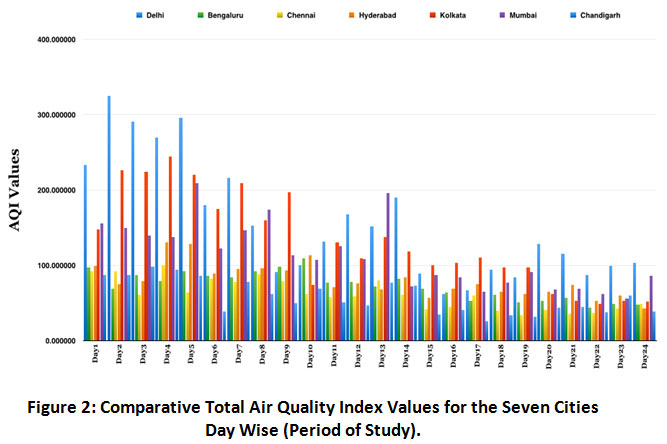 |
Figure 2: Comparative Total Air Quality Index Values for the Seven Cities Day Wise (Period of Study). Click here to view Figure |
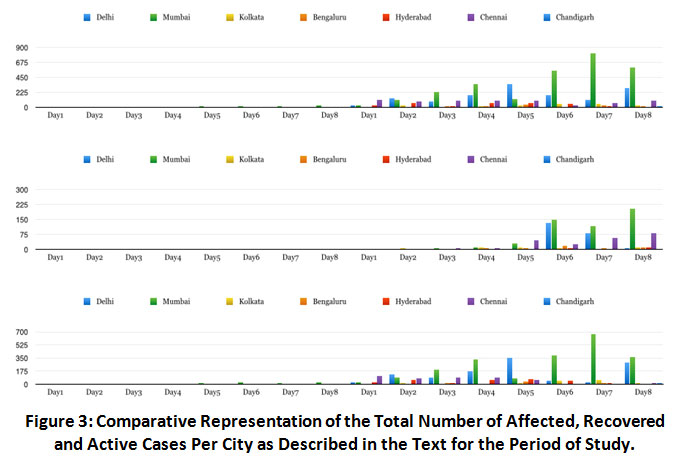 |
Figure 3: Comparative Representation of the Total Number of Affected, Recovered and Active Cases Per City as Described in the Text for the Period of Study. Click here to view Figure |
 |
Figure 4: Mean Values of AQI (a), PM2.5 (b), PM10 (c), NO2 (d), NH3 (e), SO2 (f), CO (g) and Ozone (h). Green and Blue Column Representing Pre and Post Lockdown Phase Respectively. Click here to view Figure |
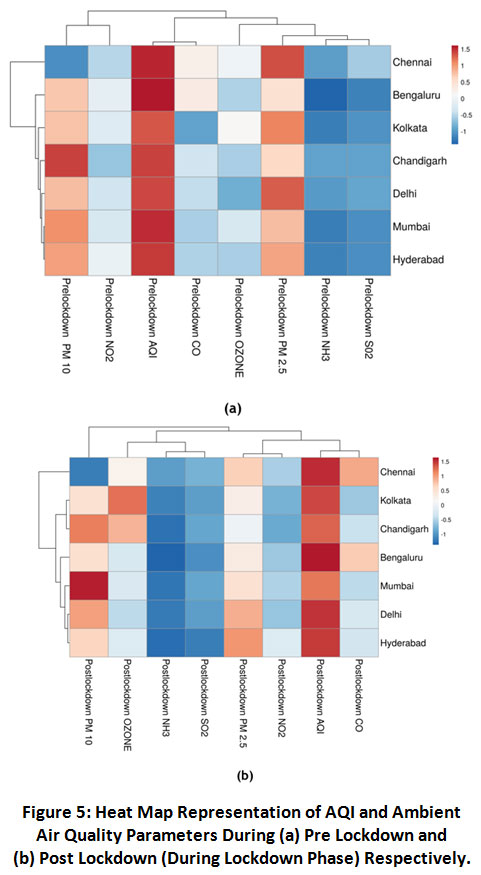 |
Figure 5: Heat Map Representation of AQI and Ambient Air Quality Parameters During (a) Pre Lockdown and (b) Post Lockdown (During Lockdown Phase) Respectively. Click here to view Figure |
The data exhibited variation in relationship between the AQI values & Post lockdown COVID-19 incidences among the enlisted cities. Kolkata & Delhi exhibited moderate significance (R2=0.64 & 0.51, respectively) at the time of this study, whereas the other cities under consideration displayed weak association in this context (Table 5). Statistically the R2 value ranging from 0.3-0.5 indicated weaker correlation, from 0.5-0.7 indicated moderate effect and above 0.7 was considered to have a strong correlation between the variables.32 Observations from this study depicted that AQI along with ambient air pollutants also manifested different effects on COVID-19 incidences. Amidst all air pollutants in Delhi, PM10 & Ozone had moderate effect; in Mumbai, PM10 & ozone; in Kolkata, SO2, CO & Ozone; in Bengaluru, NO2 & CO had higher association with COVID -19 cases, as inferred from the R2 values tabulated in (Table 5) & graphical representations from (Figure 6).
Table 5: R2 Values Obtained from the Regression Analysis of COVID Incidence with AQI and other Ambient Air Pollutants.
|
Parameters |
R2 Value |
||||||
|
|
Delhi |
Mumbai |
Kolkata |
Bengaluru |
Hyderabad |
Chennai |
Chandigarh |
|
AQI |
0.518 |
0.1981 |
0.6436 |
0.0156 |
0.1207 |
0.0211 |
0.1101 |
|
PM2.5 |
0.189 |
0.4626 |
0.5647 |
0.001 |
0.1169 |
0.0185 |
0.0005 |
|
PM10 |
0.501 |
0.9989 |
0.5936 |
0.7064 |
0.0092 |
0 |
0.1404 |
|
NO2 |
0.009 |
0.6867 |
0.4198 |
0.8821 |
0.0957 |
0.1351 |
0.063 |
|
NH3 |
0.011 |
0.0176 |
0.6447 |
0.1143 |
0.1608 |
0.0121 |
0.2161 |
|
SO2 |
0.295 |
0.0453 |
0.9996 |
0.0018 |
0.1286 |
0 |
0.7662 |
|
CO |
0.01 |
0.3164 |
1 |
0.9996 |
0.1523 |
0.0042 |
0.1375 |
|
OZONE |
0.688 |
0.9998 |
1 |
0.1609 |
0.4707 |
0.084 |
0.0103 |
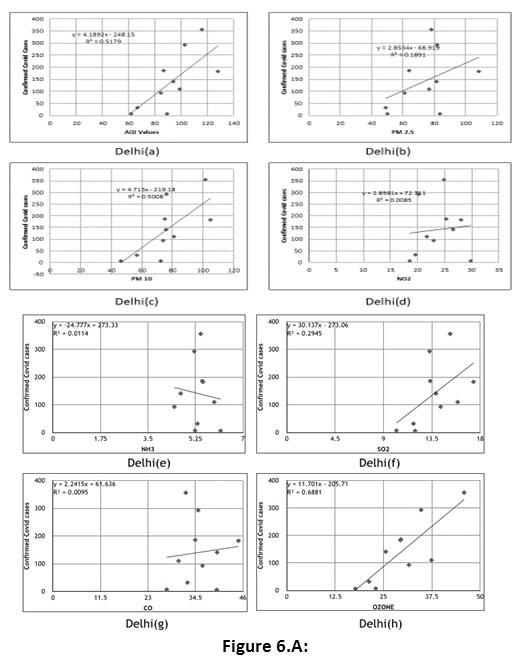 |
Figure 6.A: Click here to view Figure |
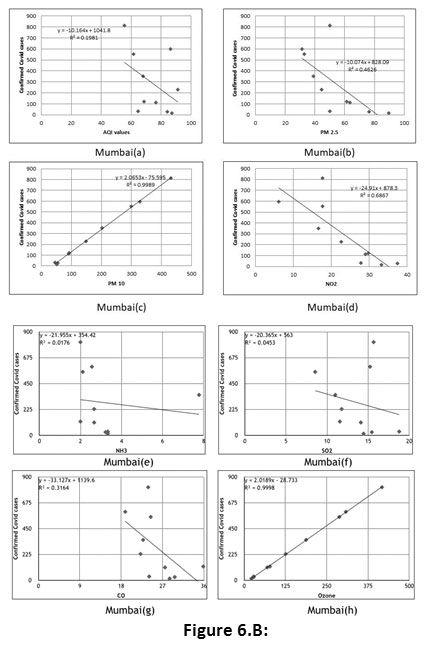 |
Figure 6.B: Click here to view Figure |
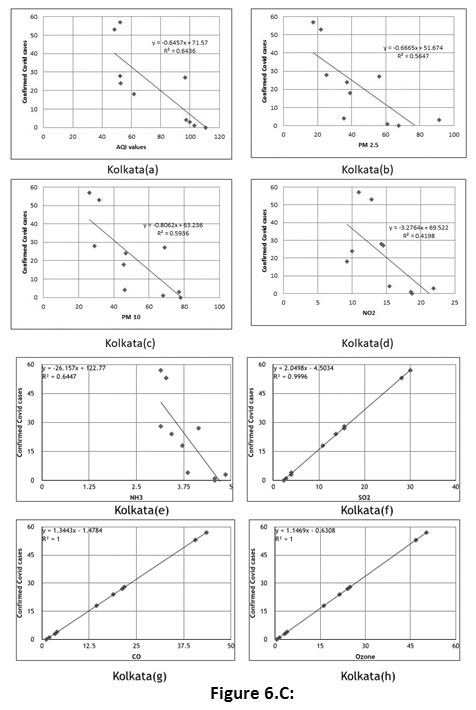 |
Figure 6.C: Click here to view Figure |
 |
Figure 6.D: Click here to view Figure |
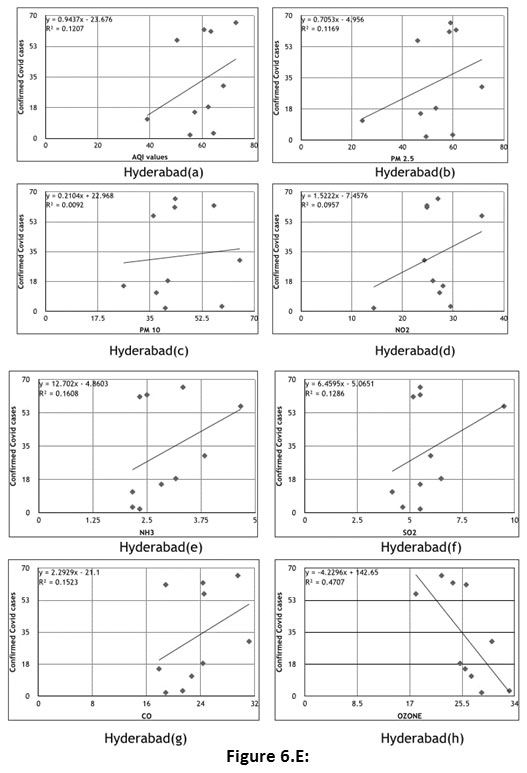 |
Figure 6.E: Click here to view Figure |
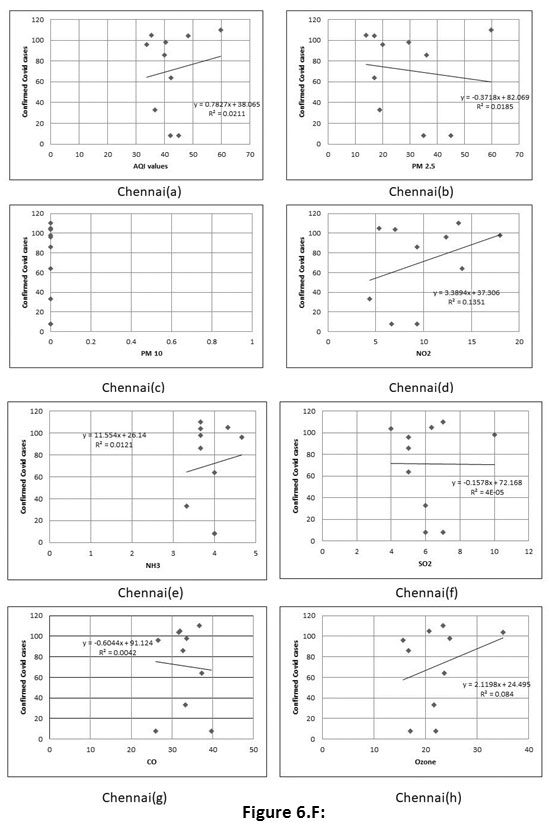 |
Figure 6.F: Click here to view Figure |
 |
Figure 6.G: Click here to view Figure |
Figure 6: Graphical Representation of Regression Analysis Performed Between COVID Incidence and Air Quality Parameters of Seven Cities. (Fig. 6.A: Delhi; Fig. 6.B: Mumbai; Fig. 6.C: Kolkata; Fig. 6.D: Bengaluru; Fig. 6.E: Hyderabad; Fig. 6.F: Chennai; Fig. 6.G: Chandigarh).
Discussion
From this study it was noticed that the post lockdown period caused a significant reduction of the AQI values of each city by parallel enhancement of air quality due to scarce level of vehicular and industrial air pollutants.
From the heat map, it was observed Chandigarh was independent and out of the cluster of other cities, in the pre lockdown phase. Having only one AQI measuring station, Chandigarh had the least value of all air pollutants except NH3 (Figure 4). Vehicular and industrial pollution emit PM, SO2, NO2 and CO but not NH3, which projected that Chandigarh has different pollution status than the other cities considered in this study. Chandigarh has lesser number of industries (mostly packaging or paper making industries) that emit lesser pollutants which probably contribute towards its position in the heat map.
In the post lockdown phase Delhi, Mumbai, Bengaluru and Hyderabad were in a single cluster as they probably have a similar emission status. This can be justified from the similar industrial and vehicular pollution standard near the air quality measuring stations. Column graphs depicted that Delhi, Mumbai and Bengaluru have significantly higher SO2 and CO level compared to other cities in either of the phase due to the presence of higher number of industries in them (Figure 4). SO2 and CO were the primary gas emitted from the industries and NO2, PM10 and PM2.5 were principal emission of automobiles (Table 1), which probably ascertain a constant level of air pollutants in the cities clustered together. As Kolkata, Chennai and Chandigarh have very less industries located in the city and lockdown norms restricted the automobile emissions, these cities were clustered separately in the heat map.
There has been previous reports of corelation between air pollution and virus mediated respiratory disorder.33 A study also highlighted considerable potency in enhancement of virulence and infection rate of influenza with the effect of air quality parameters.34 Air pollutants such as PM2.5 and PM10, carbon monoxide, sulphur dioxide, ozone and nitrogen dioxide cause severe respiratory tract infection by enhancing susceptibility.35 Higher percentage of air pollutant may promote greater persistence of air borne virus particles.36 It has the potential to favour a passive diffusion of SARS-CoV-2, in addition to the direct diffusion of the viral particles from individual to individual.37 People living in zones with high concentrations of air pollutants are more susceptible to respiratory diseases.38 In this study, only Kolkata and Delhi showed significant relationship of AQI with COVID-19 incidence with a statistically significant R2 value. Moreover, these two cities also have a significantly higher level of pollution in both the period. Observation are in concurrence to previous studies that enhanced air pollutants in the air might have been a reason for the higher confirmed cases of the viral infection. Chennai and Chandigarh are showing lowest AQI in either of the period which justifies its significantly low confirmed cases of infection as compared to the other cities.
Particulate matters are known for its suspension form in the air and invasion of the respiratory barriers to penetrate the pulmonary tract mucosal layers and directly get in contact with respiratory surfactant causing health hazards. PM2.5 and PM10 particles are having less than 2.5 and 10 micrometres of diameter respectively. PM2.5 and PM10 are the most important air pollutants in correlation to viral particle transmission. Northern Regions of Italy, which were most affected by COVID-19, had significantly higher PM10 and PM2.5 level.37 Study also showed that the viral infection has increased in the presence of abundant particulate matter such as PM10 in air.39 In our study, Delhi, Mumbai, Kolkata and Bengaluru have significantly higher values of PM2.5 and PM10 and also the R2 values suggesting a strong relationship with confirmed COVID cases. This supports the justification that higher particulate matter in air in the locations mentioned has contributed towards higher viral transmission. Moreover, this condition is significantly lesser adverse in other cities due to relatively lesser PM2.5 than PM10.
Increased O3 level has been correlated with reduction of NO2 emissions.40 These results are coherently supported by the recent findings for Milan in Italy41 and for Wuhan area in China.42-44 Experiment showed that the drastic reductions in NO2 and other air pollutants during Milan’s COVID-19 lockdown led to substantial increase in ground level Ozone (O3).41 As a result, atmospheric oxidizing potential was elevated which escalated formation of secondary aerosols having negative impact on human respiratory tract along with an increase in COVID-19 confirmed cases.41 This trend was also observed in case of Indian metropolitans where NO2 and SO2 levels have decreased in most of the cities with a few insignificant exceptions along with the significant rise in ground level of Ozone after lock-down.23,45-46 In Delhi this observation led to a noticeable impact in the confirmed COVID cases throughout the post-lockdown phase.
In conclusion, lockdown provided a significantly good impact on the improvement of overall air quality of the cities. On the other hand, it was found that the increase of particular pollutants had an impact on the spread of viral infection. Higher confirmed cases in major cities like Delhi and Mumbai could have been due to higher air pollutants present in the air and in the cities like Chandigarh and Chennai, comparatively lower pollutant levels justified the lower rate of confirmed cases of infection.
Conflict of Interest
The authors confirm that there are no known conflicts of interest associated with this publication and there has been no significant financial support for this work that could have influenced its outcome.
Acknowledgement
The authors acknowledge the authorities of their respective institutions for providing the necessary resources and encouragement to conduct this work during the lockdown period.
References
- Li Q, Guan X, Wu P, Wang X, Jhou L, Tong Y, Ren R, Leung K. S. M, Law E. H. Y, Wong J. Y, Xing X, Xiang N, Wu Y, Li C, Chen Q, Li D, Liu P, Zhao J, Liu M, Tu W, Chen C, Jin L, Yang R, Wang Q, Zhou S, Wang R, Liu H, Luo Y, Lui Y, Shao G, Li H, Tao Z, Yang Y, Deng Z, Liu B, Ma Z, Zhang Y, Shi G, Lam T. T. Y, Wu J. T, Gao G. F, Cowling B. J, Yang B, Leung G. M, Feng Z. Early transmission dynamics in Wuhan, China, of novel coronavirus -infected pneumonia. N. Engl. J. Med. 2020;382(13):1199-1207.
CrossRef - Wu F, Zhao S, Yu B, Chen Y. M, Wang W, Song Z. G, Hu Y, Tao Z. W, Tian J. H, Pei Y. Y, Yuan M. L, Zhang Y. L, Dai F. H, Liu Y, Wang Q. M, Zheng J. J, Xu L, Holmes E. C, Zhang Y. Z. A new coronavirus associated with human respiratory disease in China. Nature. 2020;579(7798):265-269.
CrossRef - Xu B, Gutierrez B, Mekaru S, Sewalk K, Goodwin L, Loskill A, Cohn E. L, Hswen Y, Hill S. C, Cobo M. M, Zarebski A. E, Li S, Wu C-H, Hulland E, Morgan J. D, Wang L, O’Brien K, Scarpino S. V, Brownstein J. S, Pybus O. G, Pigott D. M, Kraemer M. U. G. Epidemiological data from the COVID-19 outbreak, real-time case information. Sci. Data. 2020;7(1):106.
CrossRef - WHO Director. General’s Remarks at the Media Briefing on 2019-nCoV on 11 February 2020. https://www.who.int/dg/speeches/detail/who-director-generals-remarks-at-the-media-briefing-on-2019-ncov-on-11-february-2020. 2020a. (accessed 5th April 2020).
- WHO. Coronavirus disease 2019 (COVID-19): situation report, 36. https://www.who.int/emergencies/diseases/novel-coronavirus-2019/situation-reports. 2020. (accessed 5th April 2020).
- Cucinotta D, Vanelli M. WHO declares COVID-19 a pandemic. Acta Biomed. 2020;91(1):157-160.
- WHO Director. General’s Opening Remarks at the Media Briefing on COVID19 on 11 March 2020. https://www.who.int/dg/speeches/detail/who-director-general-s-opening-remarks-at-the-media-briefing-on-covid-19---11-march-2020. 2020b. (accessed 5th April 2020).
- ECDC. European Centre for Disease Prevention and Control (European Union Agency). Situation update worldwide as of 7 April 2020. https://www.ecdc.europa.eu/en/geographical-distribution-2019-ncov-cases. 2020. (accessed 4th April 2020).
- Global Carbon Project. An annual update of the global carbon budget and trends. https://www.globalcarbonproject.org/carbonbudget/index.Htm. 2019. (accessed 4th April 2020).
- Zambrano-Monserrate M. A, Zambrano-Monserrate M. A, Ruano M. A, Alcalde L. S. Indirect effects of COVID-19 on the environment. Sci Total Environ. 2020;728:138813.
CrossRef - ESA. European Space Agency. Coronavirus lockdown leading to drop in pollution across Europe. https://www.esa.int/Applications/Observing_the_Earth/Copernicus/Sentinel-5P/Coronavirus_lockdown_leading_to_drop_in_pollution_across_Europe. 2020b. (accessed 4th April 2020).
- Liu X, Li Y, Qin G, Zhu Y, Li X, Xhang J, Xhao K, Hu M, Wang X. L, Zheng X. Effects of air pollutants on occurrences of influenza-like illness and laboratory-confirmed influenza in Hefei, China. Int J Biometeorol. 2019;63:51-60.
CrossRef - Ge X. Y, Li J. L, Yang X. L, Chmura A. A, Zhu G, Epstein J. H, Mazet J. K, Hu B, Zhang W, Peng C, Zhang Y. J, Luo C. M, Tan B, Wang N, Zhu Y, Crameri G, Zhang S. Y, Wang L. F, Daszak P, Shi Z. L. Isolation and characterization of a bat SARS-like coronavirus that uses the ACE2 receptor. Nature. 2013;503:535-538.
CrossRef - WHO. Air pollution. https://www.who.int/health-topics/air-pollution#tab=tab_1. 2016. (accessed 5th April 2020).
- Zhang Q, Jiang X, Tong D, Davis S. J, Zhao H, Geng G, Ni R. Transboundary health impacts of transported global air pollution and international trade. Nature. 2017;543:705-709.
CrossRef - Landrigan P. J, Richard F, Fisher S, Suk W. A, Sly P, Chiles T. C, Bose-O'Reilly S. Pollution and children's health. Sci Total Environ. 2019;650:2389-2394.
CrossRef - Guo H, Kota S. H, Sahu S. K, Hu J, Ying Q, Gao A, Zhang H. Source apportionment of PM2. 5 in North India using source-oriented air quality models. Environ. Pollut. 2017;231:426-436.
CrossRef - Garaga R, Sahu S. K, Kota S. H. A review of air quality modelling studies in India: local and regional scale. Curr. Pollut. Rep. 2018;4:59-73.
CrossRef - Mukherjee A, Agrawal M. Air pollutant levels are 12 times higher than guidelines in Varanasi, India. Sources and transfer. Environ. Chem. Lett. 2018;16:1009-1016.
CrossRef - Gautam S. The Influence of COVID-19 on Air Quality in India: A Boon or Inutile. Bull Environ Contam Toxicol. 2020;104(6):724-726. doi:10.1007/s00128-020-02877-y
CrossRef - Gautam AS, Dilwaliya NK, Srivastava A, Kumar S, Bauddh K, Siingh D, Shah MA, Singh K, Gautam S. Temporary reduction in air pollution due to anthropogenic activity switch-off during COVID-19 lockdown in northern parts of India. Environ Dev Sustain. 2020;1-24. doi:10.1007/s10668-020-00994-6.
CrossRef - Gautam S. COVID-19: air pollution remains low as people stay at home. Air Qual Atmos Health. 2020;1-5. doi:10.1007/s11869-020-00842-6.
CrossRef - Bherwani H, Nair M, Musugu K, Gautam S, Gupta A, Kapley A, Kumar R. Valuation of air pollution externalities: comparative assessment of economic damage and emission reduction under COVID-19 lockdown. Air Qual Atmos Health. 2020;1-12. doi:10.1007/s11869-020-00845-3.
CrossRef - WHO. Air quality detoriating in many of the word’s cities. https://www.who.int/mediacentre/news/releases/2014/air-quality/en/. 2014. (accessed 5th April 2020).
- Keuken M. P, Moerman M, Voogt M, Blom M, Weijers E. P, Röckmann T, Dusek U. Source contributions to PM2.5 and PM10 at an urban background and a street location. Atmospheric Environ. 2013;71:26-35.
CrossRef - Jarvis D. J, Adamkiewicz G, Heroux M. E, Rapp R, Kelly F. J. Nitrogen dioxide. In: World Health Organization, WHO Guidelines for Indoor Air Quality: Selected Pollutants. Copenhagen: World Health Organisation;2010:201-287. https://www.ncbi.nlm.nih.gov/books/NBK138707/.17.09.2018.
- Behera N. S, Sharma M, Aneja P. V, Balasubramanian R. Ammonia in the atmosphere: a review on emission sources, atmospheric chemistry and deposition on terrestrial bodies. Environ Sci Pollut Res. 2013;20:8092-8131.
CrossRef - United States Environmental Protection Agency. EPA Section 508 policy and procedures, Accessibility requirements, Resources about Section 508 of the Rehabilitation Act (29 U.S.C § 794 (d)). https://www.epa.gov/so2-pollution/sulfur-dioxide-basics. 1970. (accessed 5th April 2020).
- United States Environmental Protection Agency. EPA Section 508 policy and procedures, Accessibility requirements, Resources about Section 508 of the Rehabilitation Act (29 U.S.C § 794 (d)). https://www.epa.gov/co-pollution/basic-information-about-carbon-monoxide-co-outdoor-air-pollution. 1970. (accessed 5th April 2020).
- United States Environmental Protection Agency. EPA Section 508 policy and procedures, Accessibility requirements, Resources about Section 508 of the Rehabilitation Act (29 U.S.C § 794 (d)). https://www.epa.gov/ground-level-ozone-pollution/ground-level-ozone-basics. 1970. (accessed 5th April 2020).
- Central Pollution Control Board. Guidelines for Ambient Air Quality Monitoring. National Ambient Air Quality Monitoring Series; CPCB, Ministry of Environment and Forest, Government of India: Delhi, India. https://app.cpcbccr.com/AQI_India. 2003. (accessed 4th April 2020)
- Henseler J, Ringle C. M, Sinkovics R. R. The use of partial least squares path modeling in international marketing. In: Sinkovics R. R, Ghauri P. N. Advances in International Marketing. 20. Bingley: Emerald Group Publishing Limited; 2009:277-319. https://doi.org/10.1108/S1474-7979(2009)0000020014.
CrossRef - Luliano A. D, Roguski K. M, Chang H. H, Muscatello D. J, Palekar R, Tempia S. Estimates of global seasonal influenza-associated respiratory mortality: a modelling study. The Lancet. 2018;391(10127):1285-1300.
CrossRef - Landguth E. L, Holden Z. A, Graham J, Stark B, Mokhtari E. B, Kaleczyc E, Andersone S, Urbanski S, Jolly M, Semmensa E. O, Warrena D. O, Swanson A, Stone E, Noonan C. The delayed effect of wildfire season particulate matter on subsequent influenza season in a mountain west region of the USA. Environ. Int. 2012;139:105668.
CrossRef - Ciencewicki J, Jaspers I. Air Pollution and Respiratory Viral Infection. Inhal. Toxicol. 2007;19:1135-1146.
CrossRef - Frontera A, Martin C, Vlachos K, Sgubin G. Regional air pollution persistence links to covid19 infection zoning. J. Infect. 2020;2:38.
CrossRef - Martelletti L, Martelletti P. Air Pollution and the Novel Covid-19 Disease: a Putative Disease Risk Factor. SN Compr. Clin. Med. 2020;2:383-387.
CrossRef - Marquès M, Domingo J. L, Nadala M, Schuhmacher M. Health risks for the population living near petrochemical industrial complexes. 2. Adverse health outcomes other than cancer. Sci Total Environ. 2020;730:139122.
CrossRef - Mishra R, Pandikannan K, Gangamma S, Raut A. A, Kumar H. Particulate matter (PM10) enhances RNA virus infection through modulation of innate immune responses. Environ. Pollu. 2020;266(Pt 1):115148.
CrossRef - Bauwens M, Compernolle S, Stavrakou T, Müller J. F, van Gent J, Eskes H, Levelt P. F, Van der A. R, Veefkind A. P, Vlietinck J, Yu H, Zehner C. Impact of Coronavirus Outbreak on NO2 Pollution Assessed Using TROPOMI and OMI Observations. Geophys. Res. Lett. 2020;47(11).
CrossRef - Collivignarelli M. C, Abbà A, Bertanza G, Pedrazzani R, Ricciardi P, Miino M. C. Lockdown for CoViD-2019 in Milan: What are the effects on air quality? Sci Total Environ. 2020;732:139280.
CrossRef - Shi X, Brasseur G. P. The Response in Air Quality to the Reduction of Chinese Economic Activities during the COVID-19 Outbreak. Geophys. Res. Lett. 2020;47(11).
CrossRef - Huang C, Wang Y, Li X, Ren L, Zhao J, Hu Y, Zhang L, Fan G, Xu J, Gu X, Cheng Z, Yu T, Xia J, Wei Y, Wu W, Xie X, Yin W, Li H, Liu M, Xiao Y, Gao H, Guo L, Xie J, Wang G, Jiang R, Gao Z, Jin Q, Wang J, Cao B. Clinical features of patients infected with 2019 novel coronavirus in Wuhan, China. The Lancet, 2020;395:497-506.
CrossRef - Wang W, Xu Y, Gao R, Lu R, Han K, Wu G, Tan W. Detection of SARS-CoV-2 in Different Types of Clinical Specimens. JAMA. 2020;323(18):1843-1844.
CrossRef - Gupta A, Bherwani H, Gautam S, Anjum S, Musugu K, Kumar N, Anshul A, Kumar R. Air pollution aggravating COVID-19 lethality? Exploration in Asian cities using statistical models. Environ Dev Sustain. 2020;1-10. doi:10.1007/s10668-020-00878-9.
CrossRef - Gautam S, Trivedi U. Global implications of bio-aerosol in pandemic. Environ Dev Sustain. 2020;22:3861-3865. https://doi.org/10.1007/s10668-020-00704-2.
CrossRef






